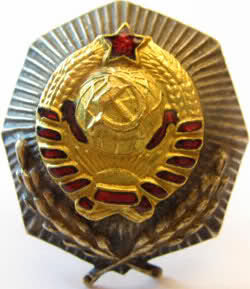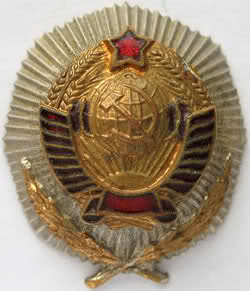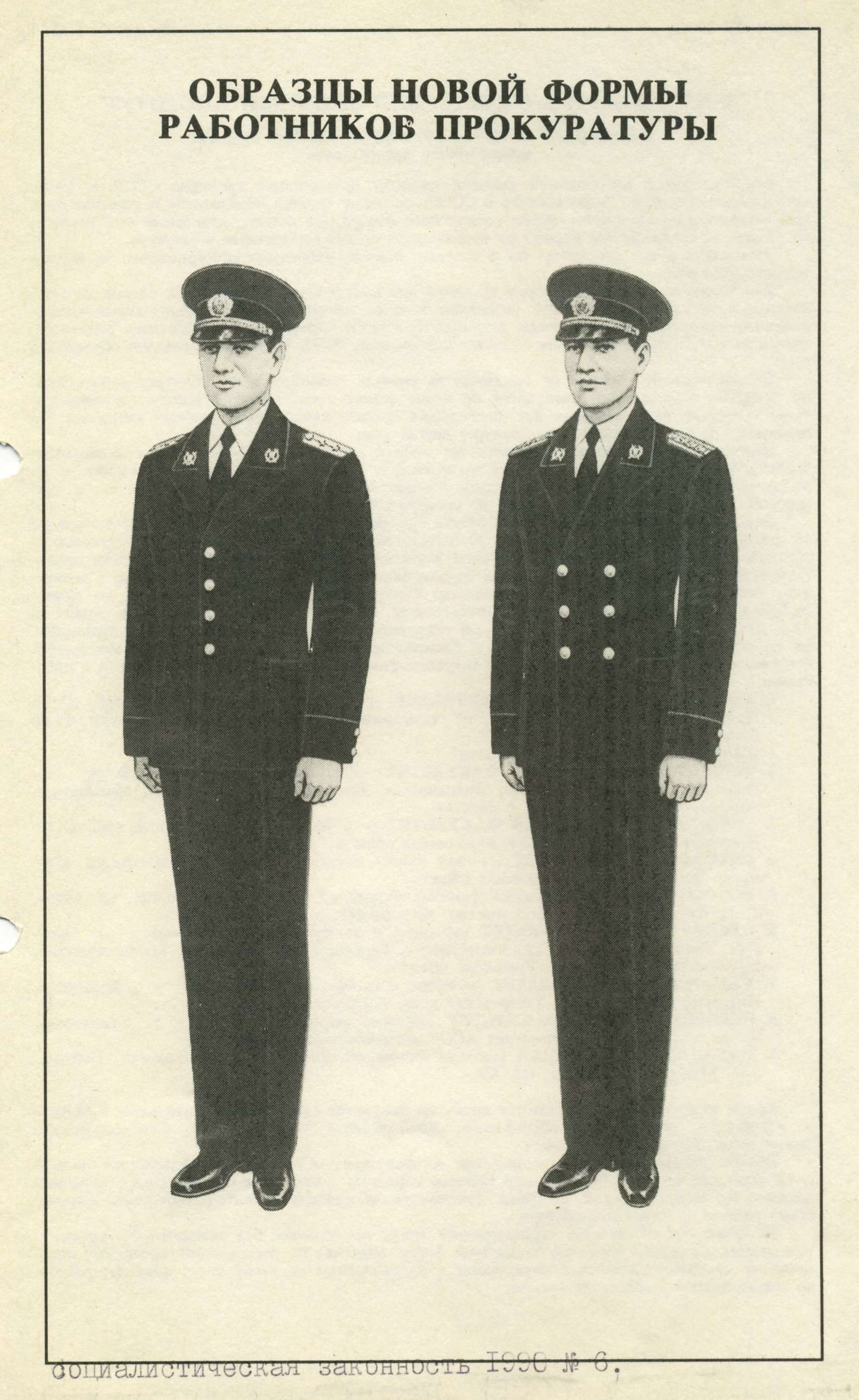 Caps of Court Officials
Caps of Court OfficialsMilitary-style Procuracy uniforms were first prescribed in 1943. At that time, dress uniforms were dark blue, service were dark brown and summer jackets were white. However, all caps were dark blue with black velvet bands and green piping. White covers were worn in summer. This color scheme remained standard throughout the history of the Soviet Procuracy. In 1954, the parade/service dress distinctions were eliminated and all uniforms standardized as dark blue (again with white jacket and cap cover optional in the summer for middle grades and higher). Although uniforms evolved further in the late 60s and 70s, no regulations for this period have been discovered and published. In 1989, some preliminary uniform changes were published (including a cap discussed below), but again, little additional information is available on these largely unimplemented changes. Unfortunately, my display of the evolution of Procuracy caps is somewhat small, reflecting the limitations of my own collection and lack of material on Russian websites. However, I will endeavor to piece together enough information to satisfy most of your questions. I will also describe the cap worn by Court Bailiffs in the 1970s and 80s.
| The evolution of Procuracy cap cockades is shown below. At far left is the initial one introduced in 1943 - showing 11 republic banners. This was modified in 1946, with the cockade in the middle now showing 16 banners for the five new republics. In 1954, the cockade was significantly revamped - as seen here to the far right. This latter cockade was initially manufactured in tombac (red brass) with hot enamel. On or about 1964 cockade material was changed to aluminum with cold enamel (paint). In either case, the cockade was always two-part. This last cockade remained in service through 1991. |
 |
 |
 |
 Procuracy
Procuracy
Officials
1954-1970?
This cap in a Russian collection would have been worn by all but the highest Procuracy staff, according to 1954 regulations (highest staff would have worn gilt cords vice the chinstrap shown here).
The crown is the smaller size used before crowns were enlarged in the 1970s. It is dark blue while the band is black velvet. Piping is green. The strap is black oilcloth and the visor - while oddly large - is black painted fiberboard.
Two gilt buttons embossed with the Great Seal of the USSR held this strap in place. The cockade is the 1954 model, a two-piece construction made from tombac and enamels.
Rare
Procuracy
Officials - Summer
1970s-1989
From the time Procuracy uniforms were introduced in 1943, officials always had the option of wearing a white cotton top over the standard cap as part of their white summer tunic uniform.
This 1984-dated cap illustrates the last version of such a cap. The crown is the larger size introduced sometime in the 1970s. The underlying
cap colors remain the same: dark blue body, black velvet band and green wool piping. The visor is black plastic and the gilt plastic buttons are cast with the Soviet "Great Seal."
The cockade is the standard two-piece aluminum model dating from the late 1960s. Gilt cords are worn - which I believe were authorized sometime between the late 1960s and 80s
for all personnel in lieu of the earlier standard black chinstrap.
Scarce
 An illustrated extract of Procuracy uniform regulations for 1989 showed caps with gilt cords and what appears to be an emblem consisting of a wreath surrounding the M1954 cockade.
That illustration matches the 1990-dated cap shown here, indicating those regulations were starting to be implemented just before the collapse of the USSR.
The fact that this cap still has its manufacturing tag listing it as a "departmental cap," vice a Railways cap, further supports the conclusion this cap is original with this new emblem.
The colors are standard Procuracy: dark blue crown, black velvet band and green piping. The visor is the larger black plastic visor which became standard in the 1980s. The regulations confirm that
the gilt filigree cords shown here were standard
for all grades; buttons are gilt plastic, cast with a raised Great Seal of the USSR.
The cockade is the normal two-piece aluminum model while the wreath is high quality gilt wire embroidered onto a dark blue backing - all sized to fit around the relatively small Procuracy emblem and sewn to the band.
The 1989 drawings seem to indicate that this wreath/cockade combination was intended for middle and higher grades of Procuracy personnel but unfortunately there is no text available that
can confirm or deny that conclusion.
Rare
An illustrated extract of Procuracy uniform regulations for 1989 showed caps with gilt cords and what appears to be an emblem consisting of a wreath surrounding the M1954 cockade.
That illustration matches the 1990-dated cap shown here, indicating those regulations were starting to be implemented just before the collapse of the USSR.
The fact that this cap still has its manufacturing tag listing it as a "departmental cap," vice a Railways cap, further supports the conclusion this cap is original with this new emblem.
The colors are standard Procuracy: dark blue crown, black velvet band and green piping. The visor is the larger black plastic visor which became standard in the 1980s. The regulations confirm that
the gilt filigree cords shown here were standard
for all grades; buttons are gilt plastic, cast with a raised Great Seal of the USSR.
The cockade is the normal two-piece aluminum model while the wreath is high quality gilt wire embroidered onto a dark blue backing - all sized to fit around the relatively small Procuracy emblem and sewn to the band.
The 1989 drawings seem to indicate that this wreath/cockade combination was intended for middle and higher grades of Procuracy personnel but unfortunately there is no text available that
can confirm or deny that conclusion.
Rare
| The authorized colors of Procuracy caps remained unchanged from 1943 to 1991; namely a dark blue top, black velvet band and green piping. However, multiple extant examples of caps dating from the 1950s and 60s with original Procuracy cockades and buttons (like the two here) along with photographic evidence seem to indicate that some officials wore caps with blue piping. Unfortunately, no known regulations reference blue piping and the reason for this can only be speculated. One such possibility is that these caps were worn by bailiffs. No information exists as to what bailiffs wore before they got their gray and green uniform in 1971 and it seems logical to assume they wore a variant of the Procuracy uniform, possibly including a change in piping color. This assessment is admittedly tenuous and I hope that future discoveries will shed additional light on the significance of blue-piped Procuracy caps. |
|
|
 |
|
Ministry of Justice
Court Officer (Bailiff) Service
1971-1991
Subordinate to the Ministry of Justice, a Bailiff of Courts was responible for maintaining order during court proceedings. Since they served as court "police," after 1971 these bailiffs wore uniforms very similar to that of the Militia, although with green vice red distinctions.
Very little information is available on bailiff uniforms, beyond the single known set of regulations published by the Ministry of Justice on 15 March 1971. The cap on the left reflects these new uniform guidelines. It is similar in most respects to caps worn by the Militia, with matching dark gray crown but with green wool used for band and piping instead of Militia red. A black oilcloth strap is standard for all ranks and is held in place above the black plastic visor by gilt buttons stamped with the Great Seal of the USSR. This reflects the standard for all Court Officers, not a designation of a general-equivalent. The emblem is also very similar to the Militia's, but has a green cold enamel (paint) background to the wreath and hammer/sickle - vice the red on Militia cockades. Although Militiamen in 1989 wore the M77 cockade and wreath emblem on their caps, no counterpart for bailiffs is known to exist and all evidence indicates bailiffs only wore the simple (non-wreathed) cockade shown here.
The cap to the right is identical in all respects except for the substitution of gilt filigree cords for the chinstrap. This cap is dated 1989 and thus would reflect
the very last changes made while the USSR still existed. Although the 1971 regulations decreed chinstraps for all bailiffs, my study of caps worn by other ministries indicates
that cords were probably authorized for bailiffs no later than the 1980s - possibly as early as the mid 1970s. Unfortunately, since no other bailifff uniform regulations are
known to exist, this cannot be confirmed at this time.
Scarce